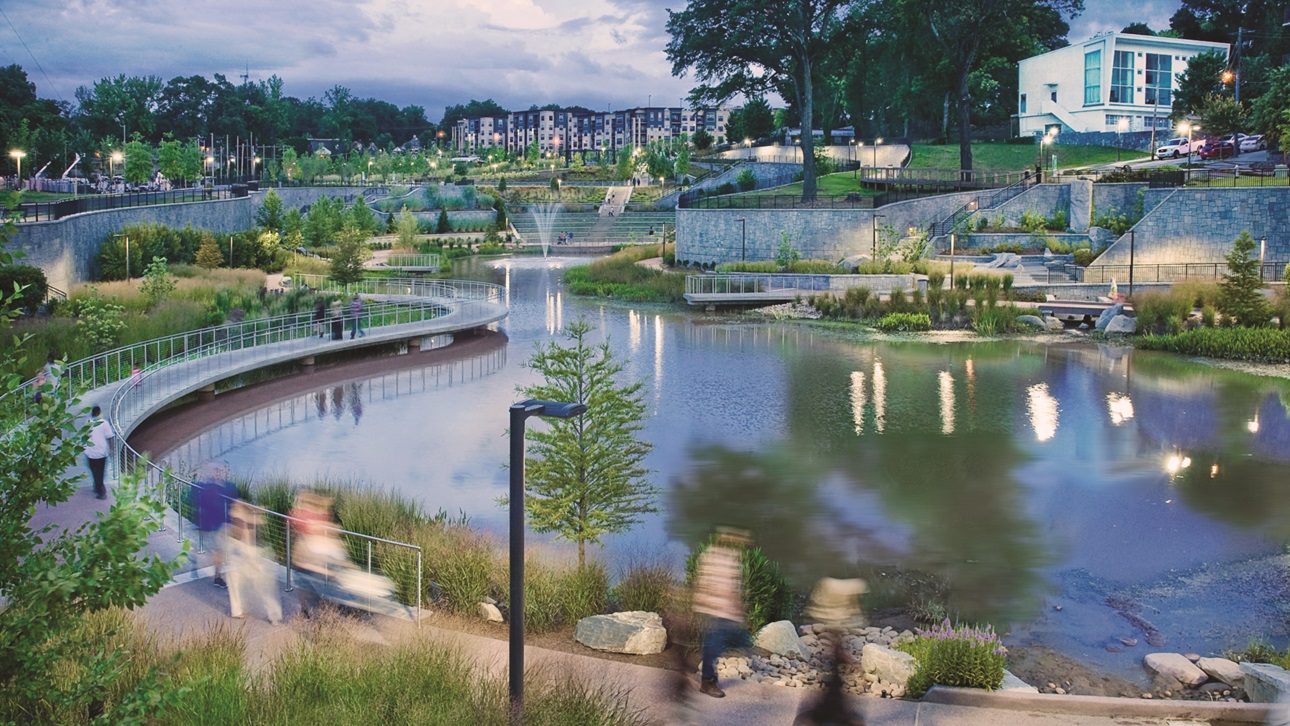- English
- 中文 (Chinese)
- Français (French)
- Deutsch (German)
- 日本語 (Japanese)
- Español (Spanish)
New York, NY: Cloudburst Infrastructure Workshop for New York City Housing Authority

In September 2021, Hurricane Ida barreled across the Caribbean and the U.S., causing $75 billion in damage. The northeast U.S. was taken by surprise by the storm’s severity as 3 inches of rain fell in an hour. Extreme rain events, whether from hurricanes like Ida or Harvey or the cloudburst that hit Copenhagen in 2011, are increasing in frequency due to climate change and many cities’ infrastructure and landscapes are not equipped to manage the intense volumes of water.
To address this challenge, ULI’s Urban Resilience program and ULI New York collaborated with the New York City Housing Authority (NYCHA) to seek innovative strategies for cloudburst management, hosting a one-day workshop with expert panelists in landscape architecture and engineering. This report presents the solutions unearthed during that workshop that developers, owners, and cities can use to boost a landscape’s ability to handle extreme rain and cloudbursts, by slowing down the flow of water, storing water in floodable areas, or restoring natural ecosystems.
Sample solutions include:
- Smart blue roofs that can detain water, determining how much water to store based on weather conditions
- Self-draining sidewalk tiles that flow into underground tubes and landscaped areas in the street
- Infiltration boxes that expand underground water storage capacity, capturing and then releasing water slowly into the soil
- Step pools along roadways – water channels that transport stormwater and resemble rocky mountain streams
- Subsoiling techniques that loosen and aerate existing soil in open areas to restore its ability to absorb water
Implementing these solutions and more, contained in the report, within NYCHA’s significant portfolio of over 300 developments that house over 400,000 low- and moderate-income residents, can create citywide impact on cloudburst management while providing a roadmap for scaling up cloudburst design strategies in cities working to become rainproof.
Résumé du rapport : In September 2021, Hurricane Ida barreled across the Caribbean and the U.S., causing $75 billion in damage. The northeast U.S. was taken by surprise by the storm’s severity as 3 inches of rain fell in an hour. Extreme rain events, whether from hurricanes like Ida or Harvey or the cloudburst that hit Copenhagen in 2011, are increasing in frequency due to climate change and many cities’ infrastructure and landscapes are not equipped to manage the intense volumes of water.
To address this challenge, ULI’s Urban Resilience program and ULI New York collaborated with the New York City Housing Authority (NYCHA) to seek innovative strategies for cloudburst management, hosting a one-day workshop with expert panelists in landscape architecture and engineering. This report presents the solutions unearthed during that workshop that developers, owners, and cities can use to boost a landscape’s ability to handle extreme rain and cloudbursts, by slowing down the flow of water, storing water in floodable areas, or restoring natural ecosystems.
Sample solutions include:
- Smart blue roofs that can detain water, determining how much water to store based on weather conditions
- Self-draining sidewalk tiles that flow into underground tubes and landscaped areas in the street
- Infiltration boxes that expand underground water storage capacity, capturing and then releasing water slowly into the soil
- Step pools along roadways – water channels that transport stormwater and resemble rocky mountain streams
- Subsoiling techniques that loosen and aerate existing soil in open areas to restore its ability to absorb water
Implementing these solutions and more, contained in the report, within NYCHA’s significant portfolio of over 300 developments that house over 400,000 low- and moderate-income residents, can create citywide impact on cloudburst management while providing a roadmap for scaling up cloudburst design strategies in cities working to become rainproof.


